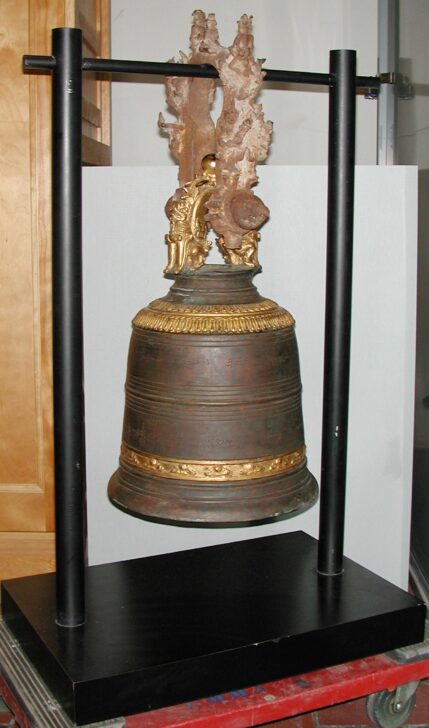Temple bell with twin crocodile handle and undeciphered inscription
Burmese

Description
President's House object Summary
Bells are second in importance only to images as gifts to a temple, and play an important role in Buddhist devotions. They are cast amidst much celebration and ceremony and can take on enormous proportions, weighing up to 90 tons and measuring 4 to 5 meters in height or diameter.
The immense bronze bells for which Burma is famous have no clappers. For sound the exterior is struck with a length of wood or the butt of a deer's antler at the completion of personal devotions as an open invitation to all sentient beings to share their merit. Onlookers' congratulatory refrains is often "Thadu, thadu, thadu," which means "Well done, well done, well done." Bells are also sounded three times by Buddhists paying homage to Buddha, Dhamma (Buddhist philosophy), and Sangha (Buddhist monastic community).
Burmese bronze bells are typically composed of 83% copper and 17% tin to insure a sweetness of tone. Onlookers throw jewelry and precious metals into the moulds during the climax of casting, which leave white and yellow streaks on the surface of the object. The ornamentation on the bell's surface is achieved by stamping designs on the malleable wax layer during production using small metal dies, while the handles and figures are made in separate moulds.
The most elaborate bells were cast during the reign of King Min-don (1853-78), when holding rings became the perching place for Burmese legendary animals. Composite animal motifs symbolize the link between humans and their broader cosmic and spiritual context, and make and female figures represent the duality that defines the Buddhist cosmic order. The inscriptions on a bell give information about its donor, creation date, and the orthography of its period.
This particular bell resembles two immense and famous Burmese bells, the Min-gun (1790) and the Maha Tissada (1841). Like the Min-gun, this bell is protected from harm by two chin-thei, or lions. Like the Maha Tissada, it features steeper sides (indicative of more recent creation date), and concentric, raised moulding.
(Laura Zahodne)
Usage Rights:
If you are interested in using an image for a publication, please visit https://umma.umich.edu/request-image/ for more information and to fill out the online Image Rights and Reproductions Request Form.